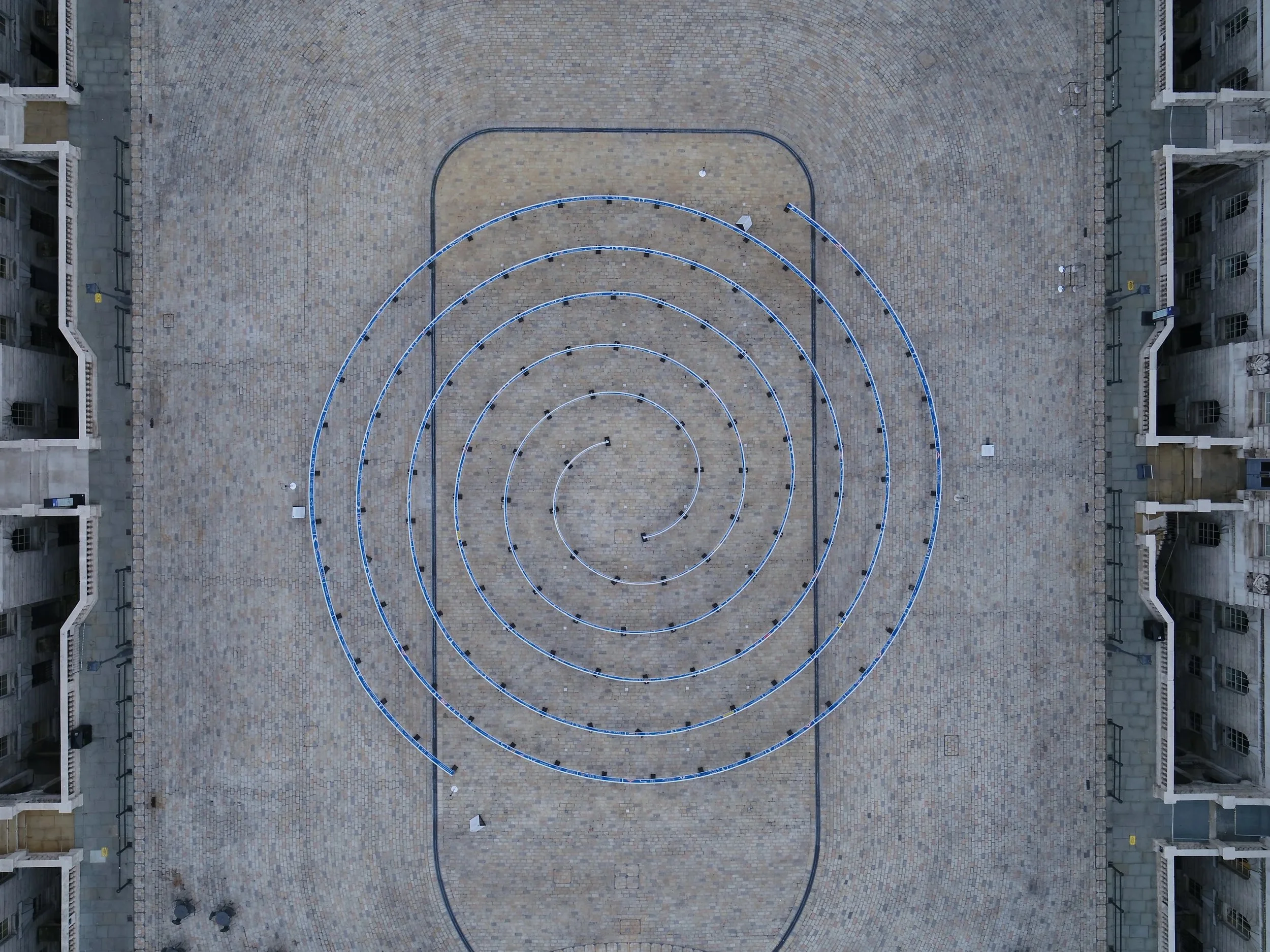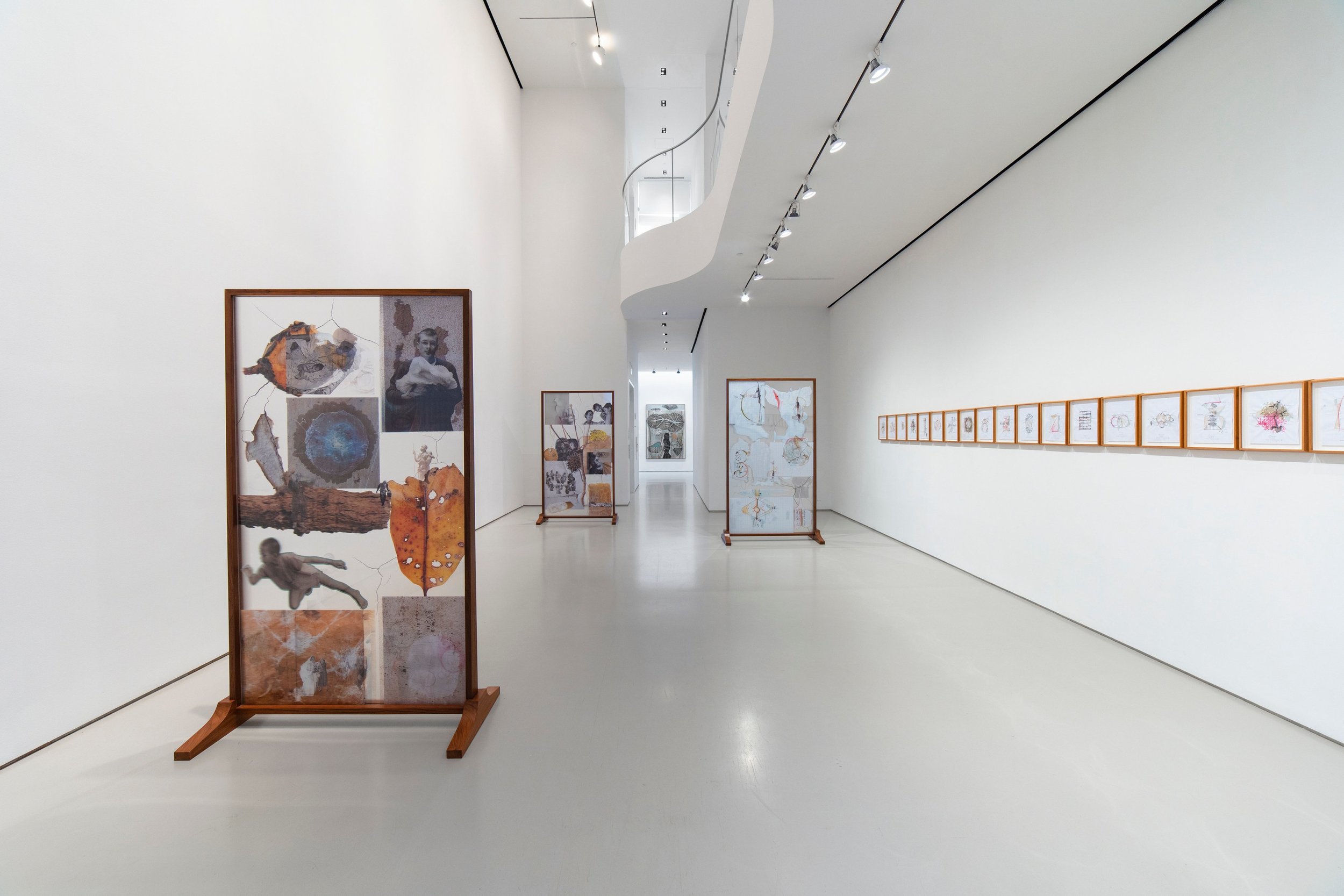
Jitish Kallat
Portrait of Jitish Kallat, 2023. Courtesy of the artist and Somerset House
Shristi Sainani speaks with Mumbai-based artist and curator Jitish Kallat about his expansive work and recent exhibitions at Somerset House and Kochi-Muziris Biennale.
Jitish Kallat has created a vast body of work that often functions at the intersections of science, philosophy, history, mathematics, and natural geometry. His oeuvre traverses varying focal lengths and time scales, from close details of the skin of a fruit or the brimming shirt pocket of a passerby to an ever-changing ledger of the planetary population. While some works meditate on the transient present, other projects, such as his Public Notice trilogy, invoke the past through citations of momentous historical utterances.
Frequently shifting orders of magnitude, Kallat's works can be said to move interchangeably between meditations on the self, the city street, the planet, and the cosmos, viewing the ephemeral within the context of the perpetual, everyday in juxtaposition with the historical, the microscopic alongside the telescopic. His work sits between fluid speculation, precise measurement, and conceptual conjectures, often interlacing the immediate and the cosmic, the past and present.
What are your first memories of art? Was there a moment of epiphany where you thought you had found your calling?
From my early childhood, I have always been obsessively drawing. Looking back, I vividly recall a moment when I was about five years old and my sister, who is eight years my senior, struggled to draw an image in her biology book. I offered to help her by drawing the picture on a separate sheet of paper. Surprisingly, my drawing turned out to be better than hers, which excited her and my family and gave me a boost of self-confidence as a child.
As a child, I recall that spell of magic that drawing holds. You can place a simple mark on a piece of paper and create space. You can add two lines and define a corner, put a figure in there, and space becomes place. You let it cast a shadow and imbued it with time. One can create a world with just a few lines like creation ex nihilo. This spontaneous emergence of form and meaning was immensely empowering. I continued to draw until my mid-teens, eventually visiting an art school where the lingering smell of paint told me I was in the right place.
Integer Studies (Drawing from Life), 2021, graphite and aquarelle pencil, stained gesso, and organic gum on Bienfang gridded paper, 11.5 x 14 inches each. Courtesy of the artist and Ishara Art Foundation
Are there texts, images, objects, scapes, or histories that you have revisited throughout your practice?
One of the recurring aspects of my work is that it frequently shifts focal lengths, exploring human stories and the infinite universe. My work often involves the interplay between the terrestrial and the celestial and a move between passages of time.
Works such as the Public Notice trilogy (2003-2010) and Covering Letter (2012) have a historical utterance at their centers. My process shifts between open-ended searches, a summoning of signs steered by nebulous intuitions, and more focused research that can examine archival records, historical references, dates, distances, and celestial cycles.
Public Notice 3, 2010, LED bulbs, wires, rubber. Courtesy of the artist and Chemould Prescott Road
Public Notice 3, 2010, LED bulbs, wires, rubber. Courtesy of the artist and Chemould Prescott Road
“One of the recurring aspects of my work is that it frequently shifts focal lengths, exploring human stories and the infinite universe.”
—Jitish Kallat
You recently opened a major public commission at Somerset House (London, UK) titled 'Whorled (Here After Here After Here).' Please tell our readers a little about its conception. Was there a specific impetus that inspired the work?
I conceived Whorled (Here After Here After Here) as a place for reflective walking. The work draws upon sacred geometry and alchemical diagrams, interlacing the immediate and the cosmic, the past and present. Two vast scrolls, both 168 meters in length, form interlocking spirals. A continuum of text and symbols following the visual language of UK motorway signage runs along the entire distance.
As visitors walk through the scrolls, these signs indicate the distance from Somerset House to over 300 locations across the planet and beyond, pointing to celestial bodies, such as the Moon, Mars, and distant stars in the Milky Way. Thus, the courtyard is reoriented in relation to terrestrial and celestial destinations, inviting visitors to take pathways through the interlaced spirals.
Several places featured in the work have fallen victim to rising sea levels, while others are known to be under the environmental threat of submersion within the next thirty years. These place names, accompanied by warning and hazard symbols, resonate with Somerset House's proximity to the River Thames and London's vulnerability to flooding.
Jitish Kallat, Whorled (Here After Here After), 2023. Courtesy of the artist and Somerset House
You have maneuvered multiple artistic mediums, from paintings and sculptures to elaborate installations — what dictates the selection? Have there been significant shifts while navigating different contexts (be that institutional or geographical)?
Fundamentally speaking, a subtle process of natural selection occurs in the studio. One observes a synchronous convergence between ideas, forms, mediums, materials, and scale at uncanny moments. Artworks typically arrive as unclear intuitions, sometimes carrying within them a discreet ‘birthing manual’ for their arrival. The complex part of the artistic process is making sense of that manual and following it to its logical conclusion with several twists along the way. An external stimulus often unravels an inner monologue which, in time, might materialize as a piece of work, be it in the form of a drawing, video, or painting.
Epicycles (installation view), 2020-2021, Sperone Westwater, New York, November 4 — December 18, 2021
Terranum Nuncius (installation view), Famous Studios, Mumbai, January 10 — January 21, 2020. Co-presented by Nature Morte, New Delhi and Chemould Prescott Road, Mumbai
Covering Letter, 2012, fog screen projection. Courtesy of the artist and Kiran Nadar Museum of Art, New Delhi. Photo by Thierry Bal
You also actively function as a curator. A significant ongoing curatorial venture is ‘Tangled Hierarchy 2’ at the Kochi-Muziris Biennale. It bases its foundation on the reproductions of the five envelopes on which Mahatma Gandhi wrote messages to Lord Mountbatten on the eve of the Partition of India. What was the core propeller behind the strategy, and what challenges or feats can you share with our readers?
Tangled Hierarchy is a speculative curatorial thought experiment with historical handwritten notes by Mahatma Gandhi at its center. The exhibition opened at John Hansard Gallery in Southampton, UK, on June 2nd, 2022, exactly 75 years since Gandhi wrote those words. Artworks, archival documents, and objects entangle into an interwoven system of inquiries.
The curatorial process is an instrument for inquiry, just as an artwork is a device for contemplating the world. My curatorial project 'Whorled Explorations' at the Kochi Biennale extended out of my long-standing artistic preoccupations… the interlacing of the celestial with the terrestrial, the engagement with the historical, with ideas of time and cartography have for long recurred in my work. The processes were substantially different - with a total shift in one's toolbox, the amount of dialogue involved, and the ambiance within which one operates. 'Tangled Hierarchy' developed from a historical document, the five envelopes from Gandhi, as several of my works have.
Tangled Hierarchy 2, Kochi-Muziris Biennale 2022, TKM Warehouse, Kochi. Photo courtesy of the Kiran Nadar Museum of Art, New Delhi
At the Kochi-Muziris Biennale, you also had an exciting conversation on time, silence, amputation, and displacement with scholar and critical theorist Homi Bhabha. What would you say was your biggest take from the discussion?
Homi and I have had an ongoing dialogue since 2010, when he contributed to a Yale Publications monograph on my work. He also delivered a wonderful lecture on my Public Notice trilogy in 2011, and since then, we've had public conversations and texts in print. As with several previous discussions, the conversation in Kochi had a free-associative element going from ideas of time, imminence, silence and speech, ethics, etc.
Are there specific projects you are looking forward to realizing next?
Tangled Hierarchy and Whorled at Somerset will close in a couple of weeks. From the 19-30th, I'm looking forward to spending ten days in a silent retreat in rural Maharashtra. Over the coming year, I'll unveil several large public commissions and a complex long-form video work I've worked on for a couple of years, among other projects.
Do you have a few last words for our readers before we close the interview?
There is always a good time to quote Tagore, so why not as a parting note? Something I read this morning: "Clouds come floating into my life, no longer to carry rain or usher storm, but to add color to my sunset sky."
Jitish Kallat
Whorled (Here After Here After)
Somerset House
London
February 16 — April 23, 2023
Jitish Kallat
Covering Letter
Kochi-Muziris Biennale
December 12, 2022 — April 10, 2023
Jitish Kallat has exhibited widely at museums and institutions including Tate Modern (London), MartinGropius-Bau (Berlin), Gallery of Modern Art (Brisbane), Kunstmuseum (Bern), Serpentine Galleries (London), Mori Art Museum (Tokyo), BOZAR: Centre For Fine Arts (Brussels), Pirelli Hangar Bicocca (Milan), Busan Museum of Art, Astrup Fearnley Museum of Modern Art (Oslo), ZKM Museum of Contemporary Art (Karlsruhe), Henie Onstad Kunstsenter (Oslo), Arken Museum of Modern Art (Copenhagen), Valencia Institute of Modern Art (Spain), Art Gallery of Ontario (Toronto), Museum Tinguely (Basel) and the Gemeente Museum (The Hague). Kallat's work has been part of the Venice Biennale, Havana Biennale, Gwangju Biennale, Asia Pacific Triennale, Fukuoka Asian Art Triennale, Asian Art Biennale, Curitiba Biennale, Guangzhou Triennale and the Kiev Biennale, amongst others.
His solo exhibitions at museums include institutions such as the Art Institute of Chicago (Chicago), Dr. Bhau Daji Lad Mumbai City Museum (Mumbai), the Ian Potter Museum of Art (Melbourne), Frist Art Museum (Nashville), Art Gallery of New South Wales (Sydney) and the Philadelphia Museum of Art (Philadelphia). In 2017, the National Gallery of Modern Art (New Delhi) presented a mid-career survey of his work titled Here After Here 1992-2017, curated by Catherine David.
Kallat was the curator and artistic director of Kochi-Muziris Biennale 2014. He has curated I draw, therefore I think (2021) for the SouthSouth Platform and Tangled Hierarchy (2022) at John Hansard Gallery Southampton and the 5th Kochi-Muziris Biennale.
Shristi Sainani is a curator, designer, researcher, and writer currently based in New Delhi, India, where she functions independently. Her interest lies in dismantling and assessing core concepts of exhibition making, specifically focusing on Contemporary Art churned through the diaspora of the Global South.
She also writes poetry, having published three books in the genre, and has contributed to several art and architectural forums. Her independent research focuses on collections and architecture of private art museums. Shristi's paper on inclusivity in museum spaces won the INSC Researchers Award in 2021.
Shristi is a formally trained architect. She completed her Bachelor of Architecture from the University of Sydney and her Master’s in Curatorial Studies from the University of Melbourne.








